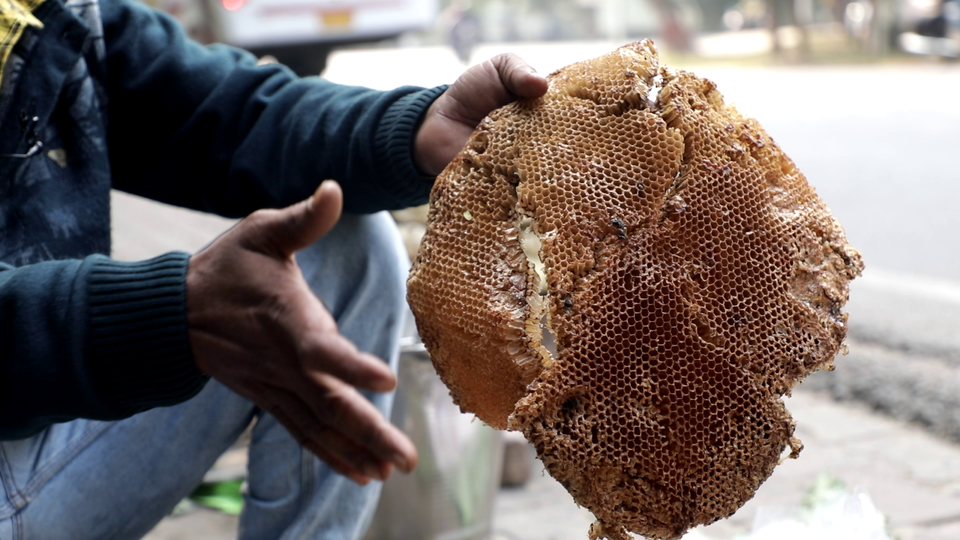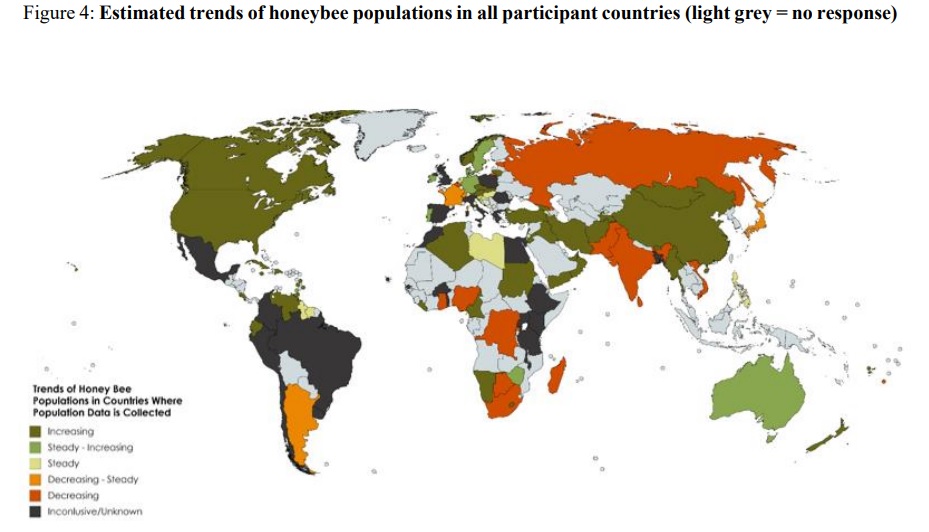How often do you hear the buzzzzz now? Why can’t you find many beehives around?
Honey collection is a major source of livelihood for many. But changing farm practices, reducing forest cover, increasing use of pesticides and growing cell phone penetration are killing honeybees

“Earlier, we had to use smoke to shoo honeybees away, but now when we go near their hives, we find many of them already dead, I don’t know why they are dying,” said Rajkishore, 42, who has been collecting honey from beehives since his childhood.
Rajkishore lives in Neemsar village in Sitapur district’s Misrikh block in Uttar Pradesh. He comes along with his nephews to the state’s capital, Lucknow, about 95 km from his home, to sell honey he collects from forests. “Bees are dying everywhere, even in the villages,” said Rajkishore.
Gaon Connection met honey sellers you would find sitting on by-lanes, to understand the changes they have been observing in their business and in honeybees over the years.
Rajveer, 31, Rajkishore’s nephew, told us that earlier, there used to be big hives in the forests. Now, they keep roaming for 2-3 days and still don’t find any hives in the very same forest.
“Earlier, we would find around 10-12 hives in the forests, now we hardly get 2-3. “Yeh to chhatta hai, kabhi mil gaya, kabhi nahi mila. (This is a hive, we find them on some days, and we don’t on the others),” added Rajveer, who has been earning a living selling honey since childhood.

Many like Rajkishore and Rajveer are dependent directly on honey and honeybees for their livelihood. As beehives become difficult to find, they do odd jobs throughout the year to manage their livelihood.
They told us that earlier they would collect 10 kg of honey per hive, but now they manage to get only 3-4 kg.
“Till about 30 years ago, farmers collected more than 70 kg of honey per season. But this amount is decreasing every year, thanks to the decreasing habitat, increasing pollution, and mobile towers,” said Dr Nitin Kumar Singh, director of Royal Honey & Bee Farming Society. Singh has been doing his research on honeybees for the past seven years.
Many instances of bee colonies suddenly disappearing have been recorded over the past 15 years — bees leave their hives in search of food, but never return. Over 90% of bees have disappeared in some regions, according to a National Geographic report.
Experts said radiation from mobile towers, unwarranted use of a particular type of pesticide, and loss of forage are the major reasons for the decreasing number of honeybees across the country.
While the population of honeybees in general is decreasing in India, there isn’t enough data on the population of the various species in the country.
Dr Preeti Virkar, a research associate at the North-Eastern Hill University in Shillong, Meghalaya, said: “Our researchers and scientists have little data on the population of honeybees in our country, but we believe that they have been decreasing region-wise in the Indian subcontinent.”
But why are bees important?
You must have now started observing that there would be hardly any beehives in your homes or the buildings next to yours.

Increasing population, decreasing pollinators
India is projected to soon surpass China as the most populous country in the world and will likely remain so throughout the current century. The world population is expected to increase to 9.7 billion by 2050.
Honeybees play a significant role in feeding the growing population and fighting hunger — they are pollinators and aid agricultural productivity.
They are also important for the yield of cash crops that provide employment to many.
Honeybees have a major contribution to the productivity of important crops such as oilseeds, fruits, and spices cultivated in India. According to the Food and Agriculture Organization (FAO) of the United Nations, bees and other pollinators boost 35% of global crop yield. “One-third of the food we eat are dependent on the pollinators,” said Dr Virkar.
According to the ‘Global survey of honeybees and other pollinators’, a report prepared by the FAO and presented to the Convention on Biological Diversity, 90% of wild flowering plants and 75% of leading food crops depend on pollinator-mediated fertilisation, which means that if bees die, in all likelihood, the crops, too, would.
Reducing forest cover and farmlands gaining vegetation result in the loss of nesting and foraging sites for bee pollinators. It could negatively affect insect pollination, thus, decreasing the production of 66% of crops, which could impact the global nutrition supply.
In India, between 1880 and 2010, the land use land cover (LULC) and forest cover decreased by 34% (134 million ha to 88 million ha), while agricultural land increased by 52% (92 million ha to 140 million ha).

Remember that bee sting pain? It boosts the immune system
A bee sting hurts, but you may be surprised to know that it could help enhance the immune system and help treat life-threatening diseases such as cancer and arthritis.
Melittin in the venom released in a bee sting may improve the effectiveness of drugs used in cancer treatment and may treat rheumatoid arthritis (a chronic inflammatory disorder affecting joints causing painful swelling). “In over 95% of cases, a bee sting will enhance a kid’s immune system,” said Dr Singh of Royal Honey & Bee Farming Society.
Farming practices not helping
Wildflowers, crops such as mustard, are the main source of food for bees, including honeybees. “There are fewer wildflowers now,” said Dr Virkar. “Farmers are doing experiments with the farming. They grow sugarcane somewhere, they grow apples somewhere else. It alters the food patterns of honeybees. One-third of the crops that we eat are dependent on pollination,” she said.
Unwarranted use of insecticides has also been contributing to the killing of honeybees. Neonicotinoid, an insecticide widely used by the farmers, affect bees by impairing their learning and memory.
Dr Singh said once bees consume nectar with pesticides, they forget the path to their homes and fail to return; they get confused and die searching for their homes.
“There is one queen bee. There are millions of workers and nurse bees. If they are affected by neonicotinoid, pollution or parasite attacks, the entire colony collapses. And no matter how good the flowering for the season is, all bees will either fly away or die,” said Dr Singh.

“Unsupportive Uttar Pradesh, supportive Himachal and Kashmir”
Farmers in many states invite beekeepers to enhance the chances of their crops get pollinated. But the general perception among some farmers in Uttar Pradesh is that inviting honeybees to their fields would damage their crops.
“There is no awareness pertaining to pollination in Uttar Pradesh,” said Dr Singh. “When we keep our bee boxes in mustard or lychee fields, farmers ask us to remove the boxes. They say our bees will suck juices from their crops and it damage them,” he said.
“But, people in Himachal (Pradesh) invite us. They also pay us when we keep our bee boxes in their fields. Farmers in Himachal, Jammu & Kashmir and Uttarakhand are supportive.”
The 10 districts in the Jammu division had 32,485 bee colonies, according to a research paper. There is little data on the number of bee colonies in Uttar Pradesh.
Varroa – the silent killer
Varroa destructor, a parasite, is one of the major contributors to the loss of bee colonies. This mite attaches to the body of honeybees and feeds on them, killing them. Sometimes entire bee colonies collapse under its attack.
“Just like a mosquito sucks blood from our bodies, this parasite sucks blood from bees,” said Dr Singh.
He said the life cycle of both Varroa destructor and the honeybee has been moving parallelly. This is why it kills most of the honeybees in a colony. “Researchers are working on getting rid of this mite, but no significant results have been achieved,” he said.

Then there are the mobile towers
Electromagnetic radiations emitted by cellphone towers are the other major reason for the decline in honey bee population. Radiations alter their communication patterns, affect their nervous system and prevent them from returning to their hives.
“When beekeepers go near honeybees with mobile phones in their pockets, we observe a change in the behaviour of the bees. They fail to sense their nectar, which is also their food. These bees die because they get disturbed,” said Dr Singh.
According to the Journal of Entomology and Zoology Studies, colonies of Asiatic honeybees present in close proximity to cellphone towers are most affected by the electromagnetic radiations emitted by them. The foraging behaviour of worker bees was found to be maximum in colonies placed at 500m from the towers, followed by those placed 1,000m, 300m and 200m or at least 100m from the towers.
Dr Singh suggested that beekeepers should keep bee boxes about 30-40 km away from mobile towers. “They should also switch off their mobile phones when they are treating bee boxes,” he said.
In India, there are about 4.5 lakh cellphone towers, and the number is expected to grow at 3-5% a year.
You would have begun observing this environmental crisis, which, Albert Einstein, a genius scientist noted long back.
“If the bee disappears from the surface of the earth, man would have no more than four years to live.” – Albert Einstein

